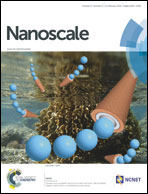Evolution of the shape of the conducting channel in complementary resistive switching transition metal oxides
Abstract
Ultimate control of the defect distribution and local conduction path in a bipolar resistive switching (BRS) Pt/TiO2/Pt sample, which was in a unipolar reset state, is provided by means of voltage pulsing and the resulting time-transient current analysis. The limited amount of oxygen vacancies in this system allowed reversibly switching-diode-like current–voltage curves, which was also confirmed in another Magnéli-phase-containing Pt/WO3/Pt sample. Such careful control of the defect distribution allowed the achievement of a complementary resistive switching (CRS) curve even from a single switching layer. The unlimited vacancy source in the Pt/TiO2/TiO2−x/Pt sample did not allow the switching-diode type and the CRS behavior. The data retention of the on-state in the BRS was critically dependent on the shape of the rejuvenated conduction channel. The required time to lead to the rejuvenation of the conducting channel was ∼70–100 ns when the threshold voltage for the BRS set of ∼−1 V was applied.


 Please wait while we load your content...
Please wait while we load your content...